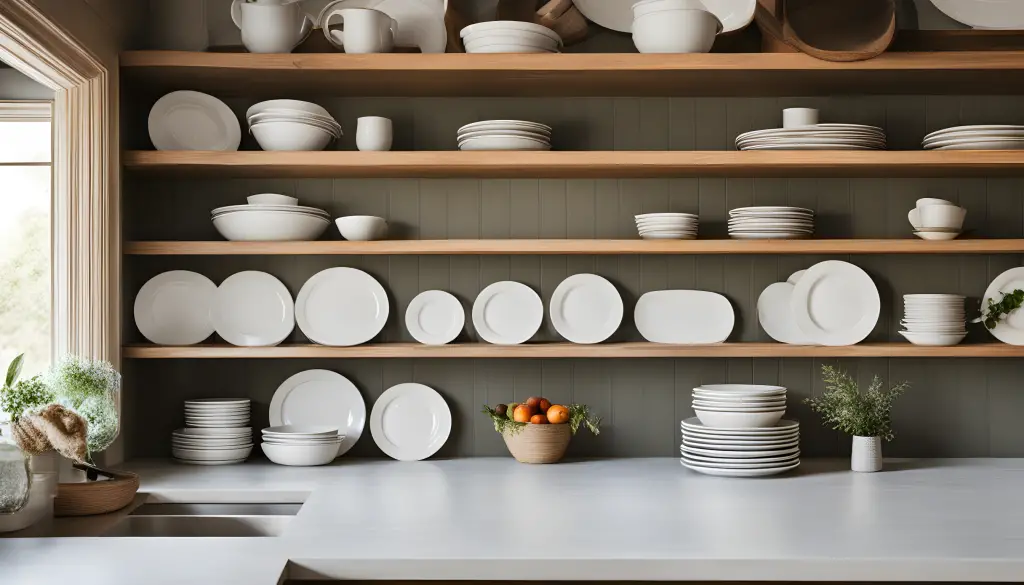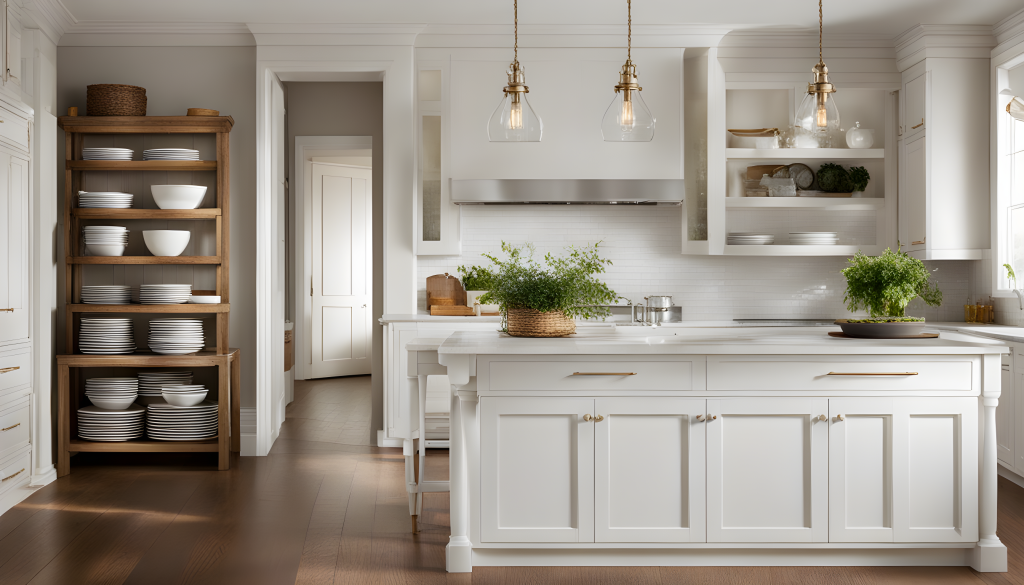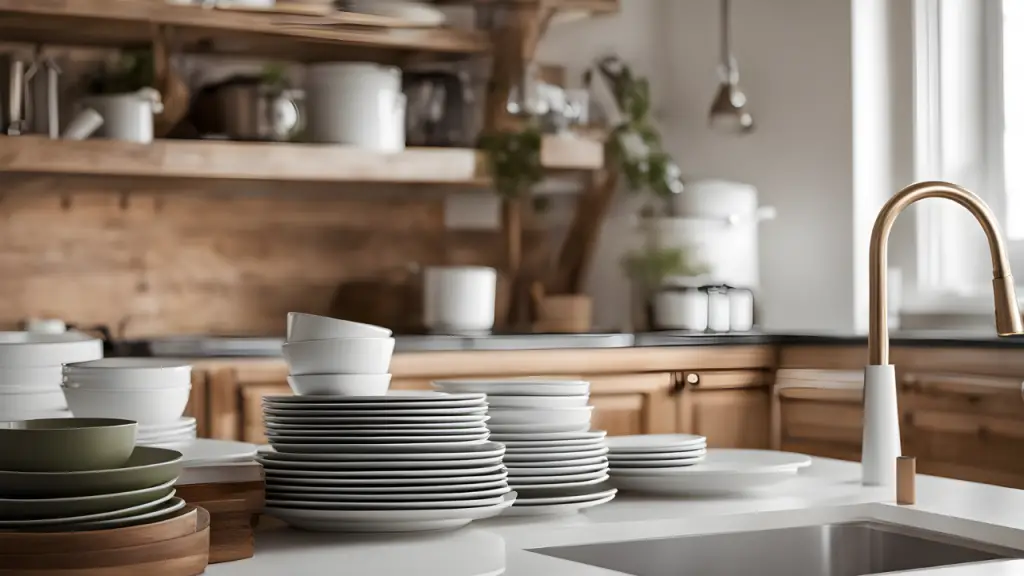Are you tired of constantly searching for your plates in your kitchen? Do you find yourself rummaging through various cabinets and drawers, only to discover that your plates are scattered all over the place?
Well, fret no more!
In this article, we will guide you on where should plates go in a kitchen, and the best places to store your plates in your kitchen, ensuring that they are easily accessible and neatly organized.
In a kitchen, plates should typically be stored in the kitchen cabinets or cupboards. These storage areas are designed to keep plates organized and easily accessible. You can arrange plates neatly on shelves within the cabinets, making sure to stack them securely to maximize space.
Additionally, consider placing plates closer to the dining area for convenience when setting the table. It’s essential to keep plates clean, dry, and protected from dust and contaminants, and storing them in cabinets is an effective way to achieve this while keeping your kitchen organized and functional.
You should consider cabinet or cupboard storage for your plates. This is a popular choice for many homeowners as it keeps the plates hidden away, creating a clean and clutter-free look in your kitchen.
By placing your plates in a designated cabinet or cupboard, you can easily stack them and keep them protected from dust and other potential damage.
Plus, with the added convenience of adjustable shelves, you can customize the storage space to accommodate your plates of various sizes.
So, next time you need a plate for dinner, simply open the cabinet or cupboard, and voila! Your plates will be right at your fingertips.
Where Should Plates Go In A Kitchen

Here are the top 5 places you can store your plates in the kitchen:
1. Cabinet or Cupboard Storage
You’ll want to store your plates in either a cabinet or a cupboard to keep them easily accessible and organized in your kitchen. When it comes to drawer organization, plates can take up a lot of space and can be quite bulky. It’s best to reserve your drawers for smaller items like utensils or kitchen gadgets.
Cabinets and cupboards are more suitable for storing plates as they provide ample space and make it easier to stack plates on top of each other. This not only saves space but also allows for efficient plate retrieval when needed.
In addition to plate stackability, cabinets, and cupboards also offer the advantage of keeping your plates safe and protected. Unlike drawers, cabinets have doors that can be closed, preventing dust or other particles from settling on your plates. This helps to maintain the cleanliness and hygiene of your plates, ensuring that they are ready to be used whenever you need them.
Furthermore, storing your plates in cabinets or cupboards also keeps them out of reach of children or pets, reducing the risk of accidents or breakage. So, whether you choose a cabinet or a cupboard, rest assured that your plates will be well-organized and easily accessible in your kitchen.
2. Drawer Storage
Keep your dishes organized and easily accessible by storing them in drawers. Drawer organization is a great option for plates as it allows you to maximize your kitchen space while keeping your plates safe and secure.
One way to keep your plates organized in drawers is by using plate dividers. These dividers can be easily inserted into the drawers to create separate compartments for each plate, preventing them from sliding around and getting damaged. With plate dividers, you can stack your plates vertically in the drawer, making it easier to see and access each plate without having to dig through a pile of dishes. This not only saves you time but also helps to prevent any accidental chipping or breaking of plates.
Another advantage of storing plates in drawers is that it allows you to keep them within reach while you’re standing at your kitchen counter or island. This makes it convenient to grab a plate when you need it, without having to walk over to a cabinet or cupboard.
Additionally, storing plates in drawers can free up valuable cabinet or cupboard space for other items such as pots, pans, or glassware. It can also make it easier to organize your kitchen by having specific drawers designated for specific types of dishes. For example, you could have one drawer for everyday plates, another for special occasion plates, and another for dessert plates. This way, you can quickly find the type of plate you need without having to search through different cabinets or cupboards.
Overall, drawer storage is a practical and efficient way to keep your plates organized and easily accessible in your kitchen.

3. Plate Rack or Shelf Storage
To maximize your storage space and add a touch of rustic charm to your culinary haven, consider incorporating a plate rack or shelf for your dish organization needs. Plate organization methods can vary, but plate racks and shelf storage are two popular options to consider. Let’s take a closer look at the pros and cons of each.
Plate racks provide a convenient and visually appealing way to display and store your plates. They come in various sizes and designs, allowing you to choose one that complements your kitchen decor. With a plate rack, your plates are easily accessible, making it quick and effortless to grab a plate for your meals.
Additionally, plate racks can help prevent your plates from chipping or breaking, as they are securely held in place. However, plate racks do take up valuable counter or wall space, so it’s essential to consider the available space in your kitchen before opting for this storage method.
On the other hand, shelf storage offers a versatile and space-saving solution for organizing your plates. By using shelves, you can make use of the vertical space in your kitchen, allowing you to store more plates in a smaller area. Shelves can be installed in various locations, such as above the sink, under cabinets, or even on an empty wall. This flexibility allows you to customize your storage arrangement based on your kitchen layout and preferences.
However, it’s important to note that shelf storage requires careful stacking and arranging of plates to prevent them from toppling over or sliding off the shelves. Additionally, if you opt for open shelves, you may need to dust or clean your plates more frequently.
To summarize, plate racks and shelf storage are both viable options for organizing your plates in the kitchen. Plate racks offer a charming display and easy accessibility, but they can take up space. On the other hand, shelf storage maximizes space utilization but requires careful arrangement and maintenance. Consider your kitchen layout, available space, and personal preferences to decide which option suits your needs best.
| Pros of Plate Racks | Cons of Plate Racks |
|---|---|
| Convenient and visually appealing | Takes up counter or wall space |
| Prevents plates from chipping or breaking | Limited capacity |
| Easy accessibility | Requires regular cleaning |
| Pros of Shelf Storage | Cons of Shelf Storage |
|---|---|
| Maximizes space utilization | Requires careful arranging of plates |
| Versatile and customizable | May require more frequent cleaning |
| Can be installed in various locations | Plates may topple or slide off shelves |
4. Wall-Mounted Plate Storage
Mounted on the wall, a wall-mounted plate storage system provides a stylish and space-saving solution for displaying and organizing your collection of plates. With a wall-mounted plate display, you can showcase your beautiful plates as decorative pieces while keeping them easily accessible.
By utilizing vertical space, this storage option allows you to free up valuable counter or cabinet space in your kitchen.
Wall-mounted plate storage systems come in various designs, allowing you to choose one that complements your kitchen decor. Whether you prefer a simple metal rack or a decorative wooden shelf, there are options to suit every style.
Additionally, these storage systems often have adjustable hooks or slots, allowing you to customize the arrangement of your plates. This flexibility enables you to create an eye-catching display that highlights your favorite plates or creates a cohesive look with matching sets.
By installing a wall-mounted plate storage system, you can transform your kitchen into a functional and aesthetic space. Not only does it provide a practical solution for organizing your plates, but it also adds a decorative element to your walls.
So, say goodbye to cluttered countertops and overcrowded cabinets, and embrace the elegance and efficiency of wall-mounted plate storage.

5. Open Shelving Storage
Embrace the simplicity and versatility of open shelving storage, creating a visually appealing display for your collection of dishes and adding a touch of modern elegance to your space.
Open shelving in a kitchen offers several benefits that make it a popular choice among homeowners. Firstly, it provides easy access to your plates and other kitchen essentials, allowing you to quickly grab what you need without the hassle of opening and closing cabinet doors. This can be especially convenient when you’re in the midst of cooking and need to quickly grab a plate or bowl.
In addition to accessibility, open shelving also allows you to showcase your beautiful dishware and add a decorative element to your kitchen. By arranging your plates in an aesthetically pleasing manner, you can create a focal point that draws the eye and adds visual interest to the room. This is particularly beneficial if you have a collection of unique or vintage plates that you want to display.
To make the most of open shelving storage, consider organizing your plates by size or color for a cohesive and visually appealing look. Utilize decorative plate stands or racks to help display your plates upright and add dimension to the shelves. By following these organizing tips, you can create a functional and visually pleasing open shelving display in your kitchen.
Conclusion
In conclusion, when it comes to storing plates in the kitchen, there are several options to consider. Cabinet or cupboard storage is a popular choice as it keeps the plates hidden away while still easily accessible.
Drawer storage is another great option, especially for smaller kitchens, as it maximizes space and keeps plates organized.
Plate racks or shelves are a stylish and functional choice, allowing for easy display and quick access to plates.
Wall-mounted plate storage is a clever solution for those who want to save counter or cabinet space, and it adds a unique decorative element to the kitchen.
Lastly, open shelving storage is a trendy choice that allows for plates to be showcased and easily reached.
Ultimately, the decision on where to store plates in the kitchen will depend on personal preference, kitchen layout, and available space. It’s important to consider factors such as convenience, accessibility, and aesthetics when making a decision.
Whether you choose to go with traditional cabinet storage, modern drawer storage, or a more decorative option like plate racks or open shelving, finding the right storage solution for your plates will help keep your kitchen organized and functional.

